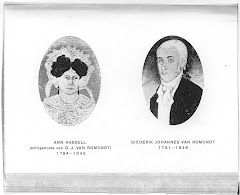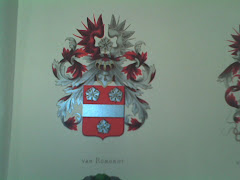 Source: http://www.museumlandvanvalkenburg.nl/html/actueel/images/Romondtportretwouter01.jpg
Source: http://www.museumlandvanvalkenburg.nl/html/actueel/images/Romondtportretwouter01.jpgProf. Wouter van Romondt Art Historian, Cartoonist and Art Artist lives in the Netherlands and is a descendant of the van Romondt, West Indian Branch.
He is son of Leo van Romondt & Maria Stortenbeeker who's father was Eduard Frederik Ferdinand van Romondt.
In the online magazine Crossroads an English-language web magazine for expatriates in the Maastricht area in The Netherlands you can read the following article.
The literary legacy of the wise king
The Círculo’s latest event took place on February 27 at the Buurthuis ’t Förtsje, a community centre in the Ebenistendreef. Art history professor Wouter van Romondt gave an engaging presentation in Dutch on “The Life and Times of Alfonso X ‘el Sabio’ (the Wise)”, the 13th century King of Castilla, León and Galicia who is famous for composing many of the medieval songs compiled in the manuscripts Las Cantigas de Santa María (“Songs to the Virgin Mary”).
Professor van Romondt studied Art History and Culture at the Academy of Fine Arts in The Hague and at the University of Utrecht. He has taught Art History at the University of Maastricht for many years and has given lectures at the behest of Maastricht’s other cultural associations, such as the Società Dante Alighieri, the Alliance Française and the Netherlands-England Society.
Although he is now retired, Professor van Romondt works during weekends as an art guide in Maastricht’s Bonnefanten Museum. In addition to this, he and his wife (who is also and art historian) have founded a cultural centre in their home, where they organise regular lectures on various artistic subjects. Every year in May they publish a booklet announcing a schedule of events and activities related to Spain, which include organised trips to admire Spain’s rich artistic heritage. Professor van Romondt and his wife have already guided several groups of up to 50 participants to Mallorca, Barcelona, Santiago de Compostela, Madrid and Andalucía.
Professor van Romondt’s connection with the Spanish language resembles that of Chairman Deckers. He was raised in Aruba, one of the Dutch Antilles islands, where he took Spanish lessons as a child. With the passing of the years, he grew interested in the strong influence of Spanish in Papiamento, the autochthonous language of Aruba and decided to learn more. This personal connection with the language and his love for Spanish art made him the ideal person to talk about the cultural and historical developments that took place in Spain under the rule of King Alfonso X.
Van Romondt’s had originally presented his lecture at the Kunstdagen (Art Days) in Wittem. A Belgian music group had been invited to perform King Alfonso’s Cantigas using Spanish medieval instruments and Professor van Romondt was asked to give a preparatory presentation. His lecture, delivered the day before the concert, explained who was King Alfonso and what were the main artistic and historic events surrounding his rule. The goal was to provide the audience with a better understanding of the zeitgeist and the history surrounding the composition of the Cantigas. Due to the large success of the event, Círculo Cervantes approached Professor van Romondt and asked him to give the same lecture for its members.
Through the use of slides depicting the major artistic accomplishments and historical developments in the Iberian Peninsula at the time, Professor van Romondt charted the cultural background in which King Alfonso composed the Cantigas. These 420 poems, written in Galician-Portuguese, form one of the largest collections of monophonic songs from the Middle Ages. All of the songs mention the Virgin Mary and many of them are devoted to recounting miracles attributed to her.
It is believed that King Alfonso was the author of many of the Cantigas, Van Romondt explained. He is certainly remembered as a “wise king” (“el sabio”) who excelled in literature, poetry, rhetoric and legal studies. When he became king in 1252, he began official initiatives to promote the study of astronomy. He also drafted the Fuero Real and Siete Partidas, two of the first codes of laws implemented in the Kingdoms of the Iberian Peninsula with a consistent judicial system. Furthermore, he encouraged the work of the Toledo School of Translators, a pioneer initiative that brought together Jewish, Muslims and Christian scholars who worked on translating texts of Greek philosophy. Under his leadership the school became one of the leading centres of culture in the world and radically increased the flow of knowledge into Christian Europe.
The members of the Círculo at the Buurthuis ’t Förtsje followed the two hour long presentation with interest. The numerous slides showing different artistic accomplishments of the period (i.e. the mosque of Cordoba, the Alhambra of Granada) and different maps of the Iberian Peninsula were and important visual component which made the lecture more engaging and informative. During the break the members had a chance to greet other friends present at the event or meet new people.
Like the Toledo School of Translators, Círculo Cervantes seeks to spread knowledge about Spain and Latin America in this part of Europe. Lovers of Spanish culture in the Limburg area should keep an eye on the upcoming activities of the Círculo. These include a presentation on Ayacucho (an Inca city in Peru) and a lecture by a member of the Spanish Embassy in Brussels (topic to be determined).
¡La llama de la cultura Española brilla en Maastricht!
By Hector Pascual Alvarez
Hector Pascual Alvarez, 21, is a Spanish student enrolled at Macalester College in Minnesota (US) where he is majoring in International Studies and Theatre Arts. He is spending the first semester of 2007 at Maastricht University as part of a study abroad programme.
Sources:To learn more on Prof. Wouter van Romondt please visit:
http://crossroads.journalismcentre.com/2007/circulo-cervantes-“se-habla-espanol”-in-maastricht/
We wish Prof. Wouter van Romondt all the best with his passion for Art!



No comments:
Post a Comment